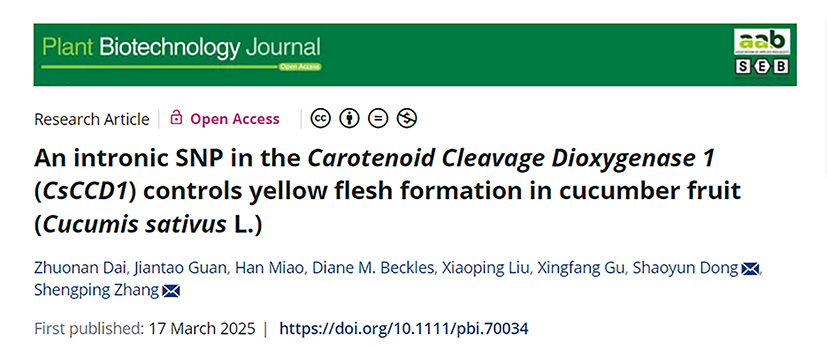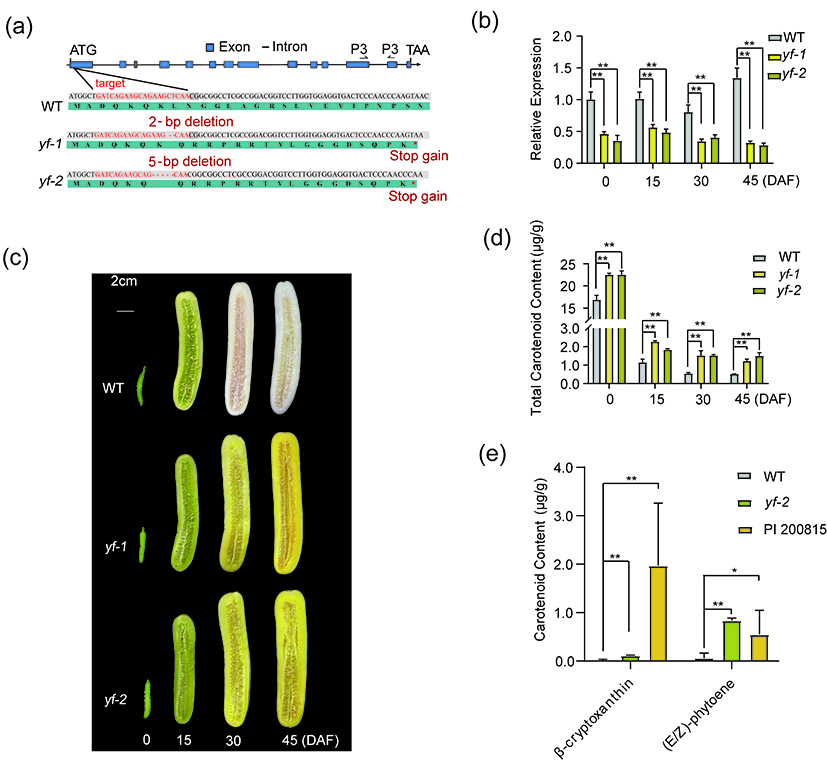Recently, Prof. Zhang Shengping’s team uncovered a new mechanism by which intron variation in the carotenoid cleavage dioxygenase-encoding gene (CsCCD1) regulates carotenoid content in cucumber fruits. They also developed new cultivated cucumber germplasm with high carotenoid content. The research findings were published in《Plant Biotechnology Journal》(IF5 year = 12.1).

Cucumber (Cucumis sativus L.) is one of the most important vegetable crop worldwide and is also the highest-yielding and economically significant protected vegetable in China. It plays a pivotal role in ensuring stable production and supply of essential agricultural products and in rural revitalization. Vitamin A is essential for maintaining normal human metabolism and physiological functions and must be obtained through diet. Vitamin A deficiency can lead to a series of health issues, including night blindness, dry eye syndrome, and weakened immune function. Carotenoids, as important precursors of vitamin A, not only convert into vitamin A in the body but also possess various physiological functions such as antioxidant activity, maintaining visual health, and regulating immunity. Therefore, breeding new cucumber varieties with high carotenoid content is of great significance for improving human dietary nutrition and promoting health.
This study map-cloned a key gene CsCCD1, which encodes carotenoid cleavage dioxygenase, regulating the formation of yellow flesh in cucumber. A single nucleotide polymorphism (SNP, A-G) in its intron leads to abnormal transcript splicing, resulting in the loss of a critical protein domain and a significant reduction in enzyme activity. This ultimately causes a substantial accumulation of carotenoids in the fruit, resulting in the yellow flesh. Xishuangbanna cucumber, a semi-wild cultivated variety unique to Yunnan Province, China, has flesh rich in β-carotene, displaying a distinct yellow flesh phenotype. Transient overexpression of CsCCD1 in the yellow-fleshed Xishuangbanna cucumber confirmed its key role in regulating flesh color in both cultivated and semi-wild cucumbers. Additionally, the study developed new cucumber germplasm with high carotenoid content with 6-7 times higher carotenoid levels. In summary, this study reveals the novel mechanism by which intronic SNP variation in CsCCD1 regulates carotenoid content in cultivated and semi-wild cucumber fruits and creates new cucumber germplasm with high carotenoid content, providing genetic resources for breeding new cucumber varieties with high carotenoid levels.

Graduate student Dai Zhuonan, Associate Researcher Guan Jiantao, and Researcher Miao Han from the State Key Laboratory of Vegetable Biobreeding at the Institute of Vegetables and Flowers, CAAS, are the co-first authors of the paper. Researcher Zhang Shengping and Associate Researcher Dong Shaoyun are the co-corresponding authors. The research was supported by the State Key Laboratory of Vegetable Biobreeding, the National Key Research and Development Program, the National Natural Science Foundation of China, the Earmarked Fund for Modern Agro-industry Technology Research System, Science and Technology Innovation Program of the Chinese Academy of Agricultural Science.
Link to this paper: https://doi.org/10.1111/jipb.13571